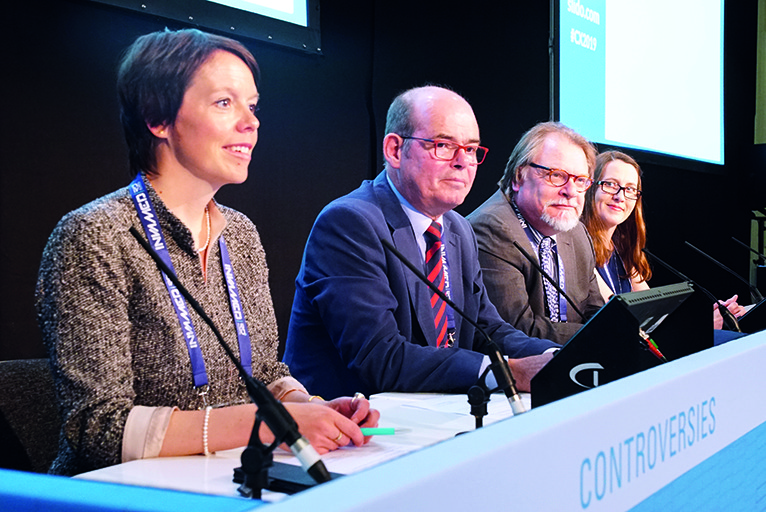 On Monday, the 2019 Charing Cross (CX) Symposium opened with the Acute Stroke Challenges programme; the session, which was chaired by Barbara Rantner (Innsbruck, Austria), Hugh Markus (Cambridge, UK) and Ross Naylor (Leicester, UK), featured five CX debates, Hot carotid Challenges, intracranial thrombectomy, and stroke after cardiac surgery.
On Monday, the 2019 Charing Cross (CX) Symposium opened with the Acute Stroke Challenges programme; the session, which was chaired by Barbara Rantner (Innsbruck, Austria), Hugh Markus (Cambridge, UK) and Ross Naylor (Leicester, UK), featured five CX debates, Hot carotid Challenges, intracranial thrombectomy, and stroke after cardiac surgery.
The debates
In the first debate of the session, 73% of the audience voted against the motion:“It is reasonable to offer urgent carotid endarterectomy (within the first 48 hours) in patients suffering a minor stroke.” Sofia Strömberg (Gothenburg, Sweden), who presented the case against the motion, reviewed the potential issues of performing endarterectomy in this timespan: increased risk of recurrent stroke and the risk of the surgical procedure. She outlined data pointing to this increased risk, and argued that, as a result, delaying the procedure to two days’ post stroke is a safer treatment option.
Clement Darling III (Albany, USA), in his bid to get the audience to vote in favour of the motion, outlined a range of studies and argued that the higher risk observed in this time window may be due to factors such as procedure timings, patient selection and surgeon experience. However, he said, offering the procedure within the 48-hour window is “absolutely” reasonable. The real question, he maintained, was how other factors may influence the outcomes of carotid endarterectomy.
The second debate of the Acute Stroke Challenges session saw the audience vote in favour of the motion—“the majority of patients with asymptomatic carotid disease do not benefit from carotid interventions”—with 76% voting in favour vs. 24% voting against. Ross Naylor (Leicester, UK), who was speaking for the motion, said: “The vast majority of patients with asymptomatic carotid disease will never benefit from a one-size-fits-all approach to treatment.” He urged that “we [physicians] need to be more selective, and identify the high risk for stroke patients, and then offer surgery or stenting”. Alun Davies (London, UK) argued against the motion, and stated that carotid endarterectomy decreases the risk of stroke, and that its “results are improving with time”. He added that it is “undoubtedly a cost-effective strategy”.
For CX Executive Board member Hugh Markus, this debate was a particular highlight of the Acute Stroke Challenges. Describing the debate as “excellent”, he told CX Daily News: “In the end, perhaps both [speakers] concluded that, in certain patients, if you can select those that are very high risk, it is worth operating, but in the majority of other patients it may not be.”
Davies had better luck in the third debate, in which 64% of the audience agreed with him that carotid revascularisation (with surgery or stenting) was not safe to be performed early after thrombolysis. This result was despite his opponent Maarit Venermo (Helsinki, Finland) raising some chuckles from the audience when she cited a paper in support of her argument that carotid revascularisation in this setting was safe on which Davies was an author. Davies countered playfully with a series of research articles to back up his point of view.
In the following discussion, Venermo maintained that the best timing is between two and seven days following thrombolysis. She cautioned against delays because of the potential for strokes to occur: “I do not think it is wise, because we never know what happens to these patients while we are waiting.” Davies stated that he would wait for a minimum of 72 hours.
In the fourth and final debate of the Hot carotid Challenges section, 75% of the CX audience voted against the motion that newer technologies and innovations have made carotid artery stenting as safe as carotid endarterectomy in the first 14 days after a transient ischaemic attack or stroke. Peter Schneider (Honolulu, USA), who was arguing for the motion, commented: “There is an increased risk of stroke [with stenting] in recently symptomatic patients but that is using outmoded devices. Proximal protection is better and proximal protection with reversed flow (i.e. transcarotid artery revascularisation or TCAR) is even better than that because it avoids the arch and has better particle capture. TCAR is as safe as endarterectomy even in patients who are recently symptomatic”.
Naylor countered this view by saying the evidence for TCAR “was not there across the whole generality of stroke patients”. While he “suspected” there would be “more equipoise” between stenting and endarterectomy in the future, at present, the evidence still favours surgery “for the vast majority of symptomatic patients undergoing intervention within seven to 14 days”.
However, the closest vote of the debate was the one in which Jan Kovac (Leicester, UK) and Andrew Clifton (London, UK) discussed whether intracranial thrombectomy should be limited to neurointerventionists. Kovac (a cardiologist), whose proposition was that it should not be limited to neurointerventionists, won the debate with 57% of the vote, but a substantial minority (43%) supported Andrew Clifton’s arguments that the procedure should be limited to neurointerventionists. While Clifton argued that experience and proper training leads to “appropriate patient selection [and] faster, safer procedures with fewer complications”, Kovac said that, given the magnitude of the potential clinical and economic benefits of mechanical thrombectomy, a “collaboration of various interventional specialists is desirable to deliver this therapy to a wider population”.
Intracranial thrombectomy
The debate on intracranial thrombectomy was part of a whole session dedicated to the procedure. Markus, who was chairing the session, called intracranial thrombectomy “one of the huge advances in stroke care at the moment”. Outlining its significance, he said “for every three patients we treat, we can cure one, so it is a massive treatment effect. It has transformed stroke care.”
In a keynote lecture, David Hargroves (Kent, UK) reviewed what thrombectomy trials “really tell us”, and how the findings can be implemented into routine clinical practice. In light of DAWN and DIFFUSE-3, he said that there is a strong evidence basis for thrombectomy and that this treatment should be available to all patients. Additionally, Hargroves posited that regional and countrywide networks are required to deliver and achieve its 10% potential reach. However, he said, caution is needed when reorganising stroke services, so as not to destabilise the ‘core’ business and therapeutic benefit of organised care, closest to home. The session was moderated by Barbara Ratner.
Thomas Liebig (Munich, Germany) looked at the use of virtual reality in thrombectomy training. He described his own training as similar to that of learning to drive a car, and contrasted it with the simulator experiences of pilots who must demonstrate their competencies in a virtual environment. Liebig pointed out that skilled performance is difficult to characterise, and then outlined his work with University College Cork (Republic of Ireland) to develop surrogate parameters for performance metrics that can be used in a simulator. The findings, he said, “have the potential not only for training purposes” but, in a nod to the earlier debate on intracranial thrombectomy, could also allow us to “discriminate between a person who can do the procedure and those who should be doing something else”.







